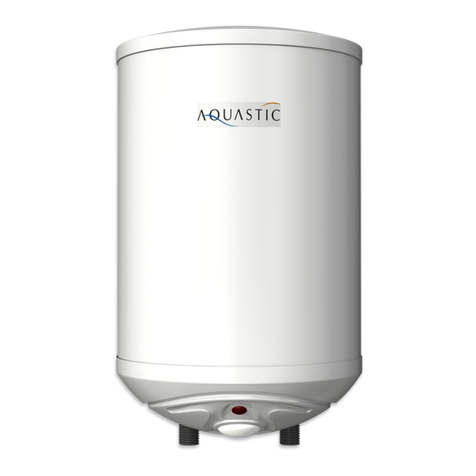The specially fired enamel design provides long life in case of aggressive (soft)
water. The main outline dimensions of the water storage are described in Figure 1
3. STORAGE INSTALLATION / DEPLOYMENT
Pursuant to regulations of Hungarian Standards IEC 60364 / HD 60364, the hot
water storage must be installed and connected to pipeline and electricity by a
professional technician.
Before installation of the unit, a professional architect has to analyze the structure
of the wall where the unit will be mounted.
The following solutions are proposed in case of different wall types:
•Stone, brick and concrete walls of thickness of 100-150 mm: hex head
bolts (Hungarian Standard M 12, EN ISO 4017), bolt washer for wood connection
(M 12). It is mounted with horizontal flat steel of 50 x 5 at the back side of the
wall.
•Really thin walls: hex head bolts (Hungarian Standard M 12, (EN ISO
4017), bolt washer for wood connection (M 12). Fixed with 2 U shaped steels of
60 x 40 x 3 (EN 10279) vertically at the back side of the wall.
4. PIPELINE CONNECTION
Any steel pipe, plastic pipe and red copper pipe or flexible pipe connection
adequate to a water pressure rated as 0.6 MPa can be used as hot or cold water
pipes.
In case of connecting red copper pipes to the pipeline system, the use of
insulating intermediate pieces is compulsory.
One of the intermediate pieces has to be mounted directly to the hot water pipe of
the water tank, while another intermediate piece has to be mounted between the
already fixed fittings and the red copper pipeline system. In case of connection
without intermediate pieces, our Company undertakes no guarantee for defects
due to corrosion of internally threaded pipe ends of the water tank, neither any
liability resulting from or related to such events.
The middle piece not accessory.
Can be ordered: 1/2" Article Nr.1252122514
The water tank should be connected to the pipeline system according to Figure 2.
IT IS AT THE RISK OF DEATH AND THEREFORE IT IS FORBIDDEN TO PUT
THE WATER TANK UNDER A PRESSURE LARGER THAN THE PERMITTED
OPERATION PRESSURE!
4.1 The combined safety valve is an accessory of the water tank. Its connection
to the hot water tank and to the pipeline system: Rp1/2 internally threaded.
The valve has to be mounted DIRECTLY in front of the water tank into the cold
water pipe, respecting the flow direction marked by an arrow. Before mounting the
valve, the cold water pipeline has to be flushed thoroughly, in order to avoid any
damage caused by any possible pollution.





























